Accounting System and Practice: Assignment Solution Details
VerifiedAdded on 2020/02/05
|20
|3560
|51
Homework Assignment
AI Summary
This document provides a detailed solution to an accounting system and practice assignment. It begins with an introduction to the role of accounting in modern business, including the use of spreadsheets. The solution covers a wide range of topics, including naming cells in spreadsheets, negative numbers, separation of data and report areas, IF functions, spreadsheet applications, perpetual versus periodic inventory systems, journal entries, worksheets and financial reports, accounting principles, inventory flow assumptions (FIFO, LIFO, Weighted Average), application of inventory flow assumptions, internal control issues, bank reconciliation, journalizing accounts receivable, estimating bad debts, evaluation of a firm's financial position, the percentage of sales method, and the dishonor of a note receivable. The assignment also includes a work-integrated assessment case study analyzing Qantas, covering topics like the application of the balance scorecard, executive compensation, board expertise, key financial metrics (Revenue Seat Factor, EBITDA, etc.), working capital ratio calculation, chart creation, and investment recommendations. The document concludes with a summary of the key concepts discussed and references used.
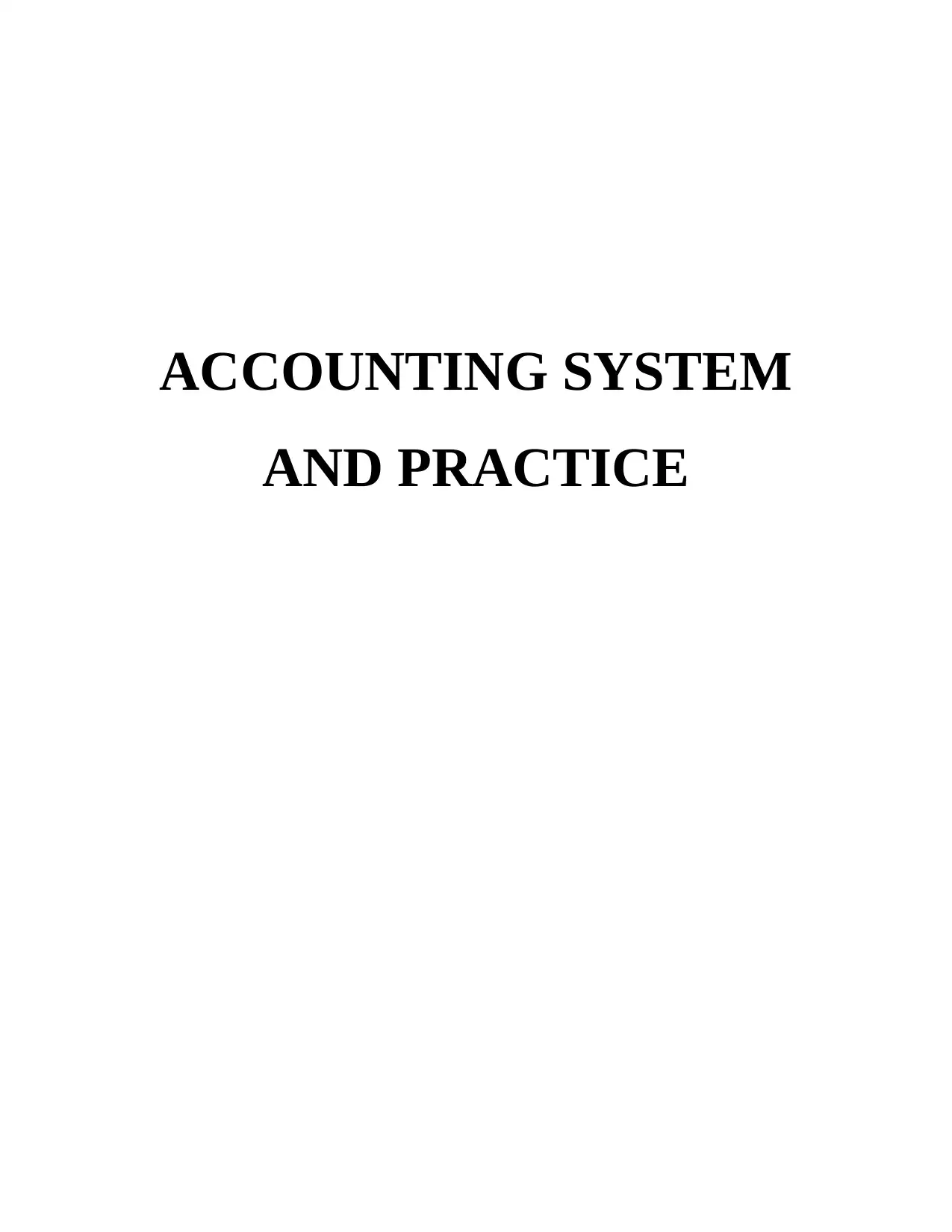
ACCOUNTING SYSTEM
AND PRACTICE
AND PRACTICE
Paraphrase This Document
Need a fresh take? Get an instant paraphrase of this document with our AI Paraphraser
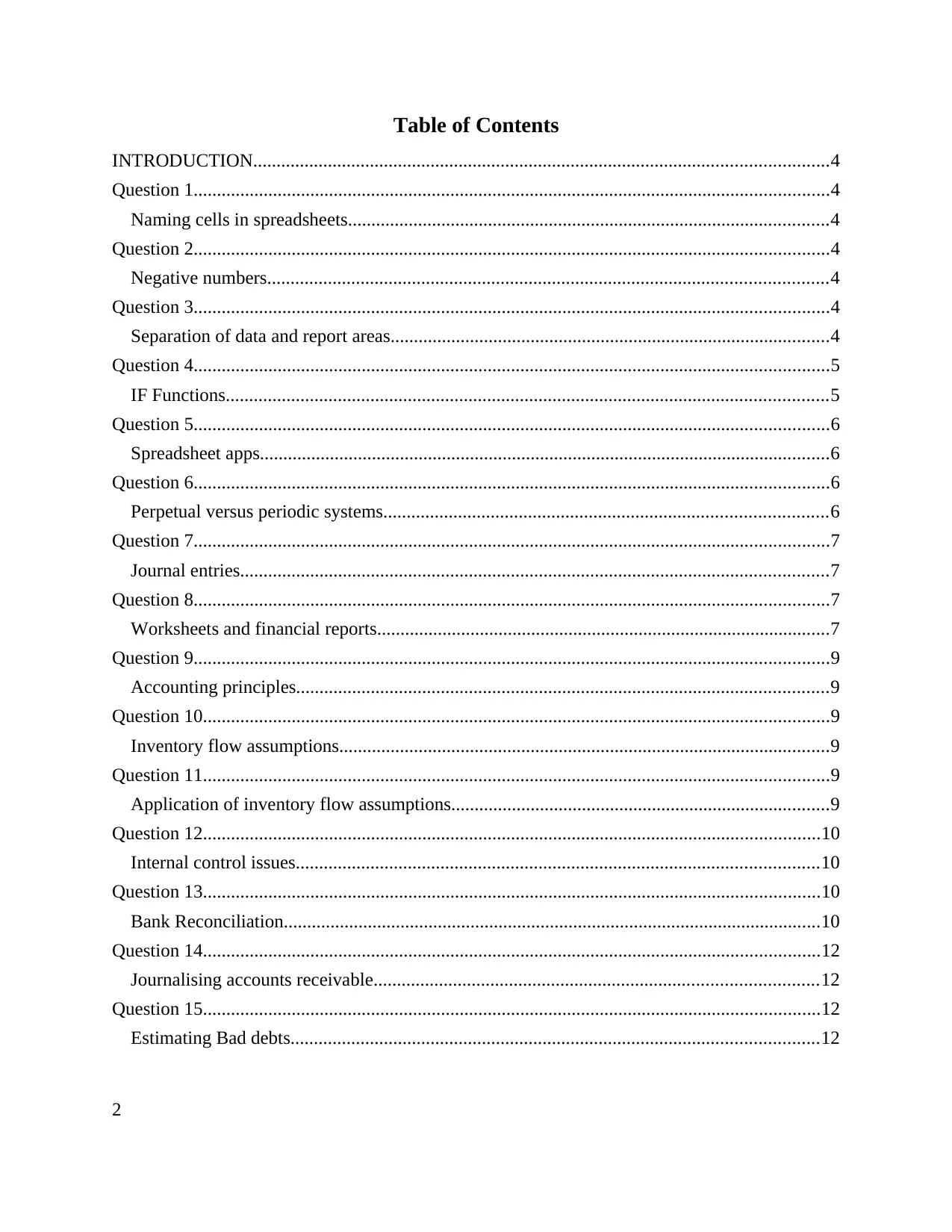
Table of Contents
INTRODUCTION...........................................................................................................................4
Question 1........................................................................................................................................4
Naming cells in spreadsheets.......................................................................................................4
Question 2........................................................................................................................................4
Negative numbers........................................................................................................................4
Question 3........................................................................................................................................4
Separation of data and report areas..............................................................................................4
Question 4........................................................................................................................................5
IF Functions.................................................................................................................................5
Question 5........................................................................................................................................6
Spreadsheet apps..........................................................................................................................6
Question 6........................................................................................................................................6
Perpetual versus periodic systems...............................................................................................6
Question 7........................................................................................................................................7
Journal entries..............................................................................................................................7
Question 8........................................................................................................................................7
Worksheets and financial reports.................................................................................................7
Question 9........................................................................................................................................9
Accounting principles..................................................................................................................9
Question 10......................................................................................................................................9
Inventory flow assumptions.........................................................................................................9
Question 11......................................................................................................................................9
Application of inventory flow assumptions.................................................................................9
Question 12....................................................................................................................................10
Internal control issues................................................................................................................10
Question 13....................................................................................................................................10
Bank Reconciliation...................................................................................................................10
Question 14....................................................................................................................................12
Journalising accounts receivable...............................................................................................12
Question 15....................................................................................................................................12
Estimating Bad debts.................................................................................................................12
2
INTRODUCTION...........................................................................................................................4
Question 1........................................................................................................................................4
Naming cells in spreadsheets.......................................................................................................4
Question 2........................................................................................................................................4
Negative numbers........................................................................................................................4
Question 3........................................................................................................................................4
Separation of data and report areas..............................................................................................4
Question 4........................................................................................................................................5
IF Functions.................................................................................................................................5
Question 5........................................................................................................................................6
Spreadsheet apps..........................................................................................................................6
Question 6........................................................................................................................................6
Perpetual versus periodic systems...............................................................................................6
Question 7........................................................................................................................................7
Journal entries..............................................................................................................................7
Question 8........................................................................................................................................7
Worksheets and financial reports.................................................................................................7
Question 9........................................................................................................................................9
Accounting principles..................................................................................................................9
Question 10......................................................................................................................................9
Inventory flow assumptions.........................................................................................................9
Question 11......................................................................................................................................9
Application of inventory flow assumptions.................................................................................9
Question 12....................................................................................................................................10
Internal control issues................................................................................................................10
Question 13....................................................................................................................................10
Bank Reconciliation...................................................................................................................10
Question 14....................................................................................................................................12
Journalising accounts receivable...............................................................................................12
Question 15....................................................................................................................................12
Estimating Bad debts.................................................................................................................12
2
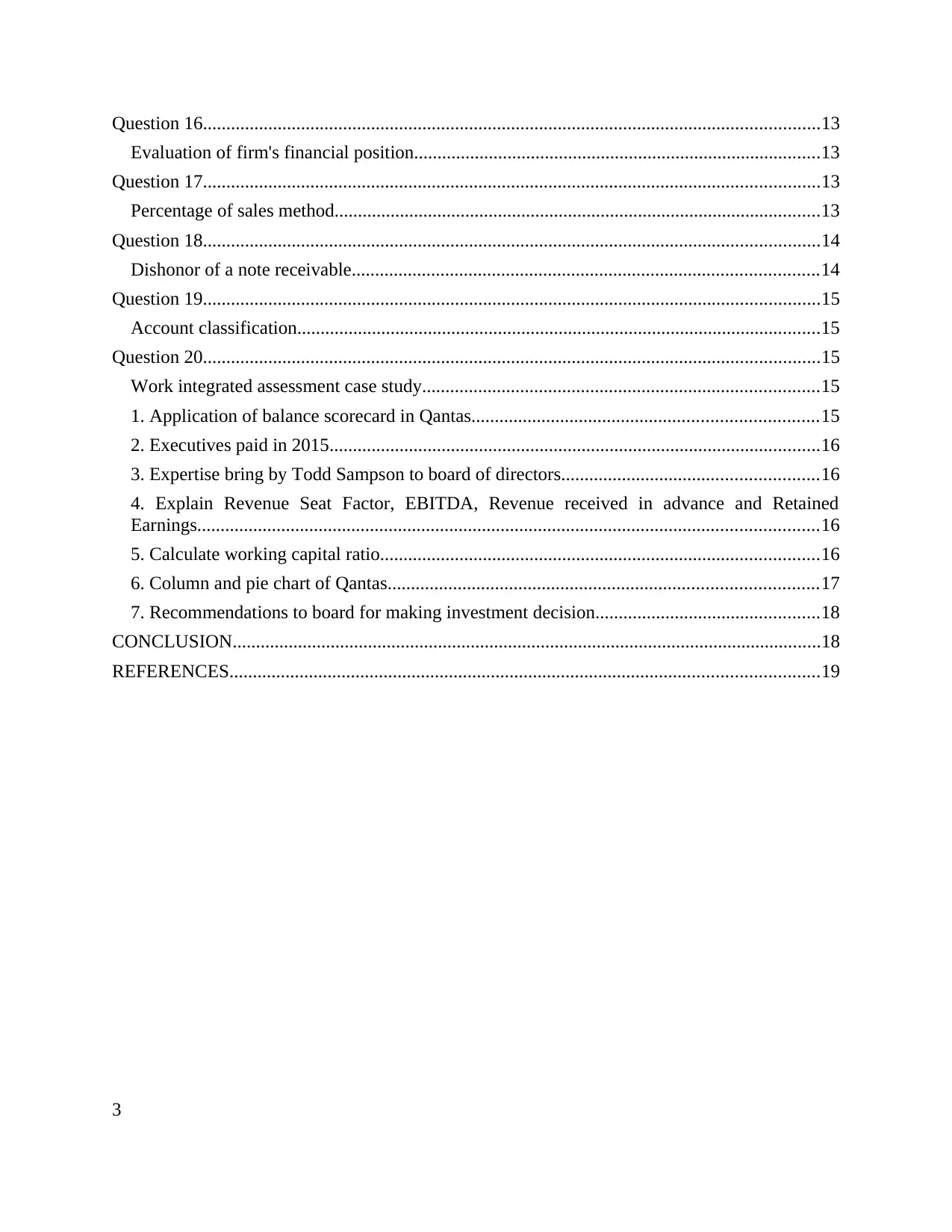
Question 16....................................................................................................................................13
Evaluation of firm's financial position.......................................................................................13
Question 17....................................................................................................................................13
Percentage of sales method........................................................................................................13
Question 18....................................................................................................................................14
Dishonor of a note receivable....................................................................................................14
Question 19....................................................................................................................................15
Account classification................................................................................................................15
Question 20....................................................................................................................................15
Work integrated assessment case study.....................................................................................15
1. Application of balance scorecard in Qantas..........................................................................15
2. Executives paid in 2015.........................................................................................................16
3. Expertise bring by Todd Sampson to board of directors.......................................................16
4. Explain Revenue Seat Factor, EBITDA, Revenue received in advance and Retained
Earnings.....................................................................................................................................16
5. Calculate working capital ratio..............................................................................................16
6. Column and pie chart of Qantas............................................................................................17
7. Recommendations to board for making investment decision................................................18
CONCLUSION..............................................................................................................................18
REFERENCES..............................................................................................................................19
3
Evaluation of firm's financial position.......................................................................................13
Question 17....................................................................................................................................13
Percentage of sales method........................................................................................................13
Question 18....................................................................................................................................14
Dishonor of a note receivable....................................................................................................14
Question 19....................................................................................................................................15
Account classification................................................................................................................15
Question 20....................................................................................................................................15
Work integrated assessment case study.....................................................................................15
1. Application of balance scorecard in Qantas..........................................................................15
2. Executives paid in 2015.........................................................................................................16
3. Expertise bring by Todd Sampson to board of directors.......................................................16
4. Explain Revenue Seat Factor, EBITDA, Revenue received in advance and Retained
Earnings.....................................................................................................................................16
5. Calculate working capital ratio..............................................................................................16
6. Column and pie chart of Qantas............................................................................................17
7. Recommendations to board for making investment decision................................................18
CONCLUSION..............................................................................................................................18
REFERENCES..............................................................................................................................19
3
⊘ This is a preview!⊘
Do you want full access?
Subscribe today to unlock all pages.

Trusted by 1+ million students worldwide
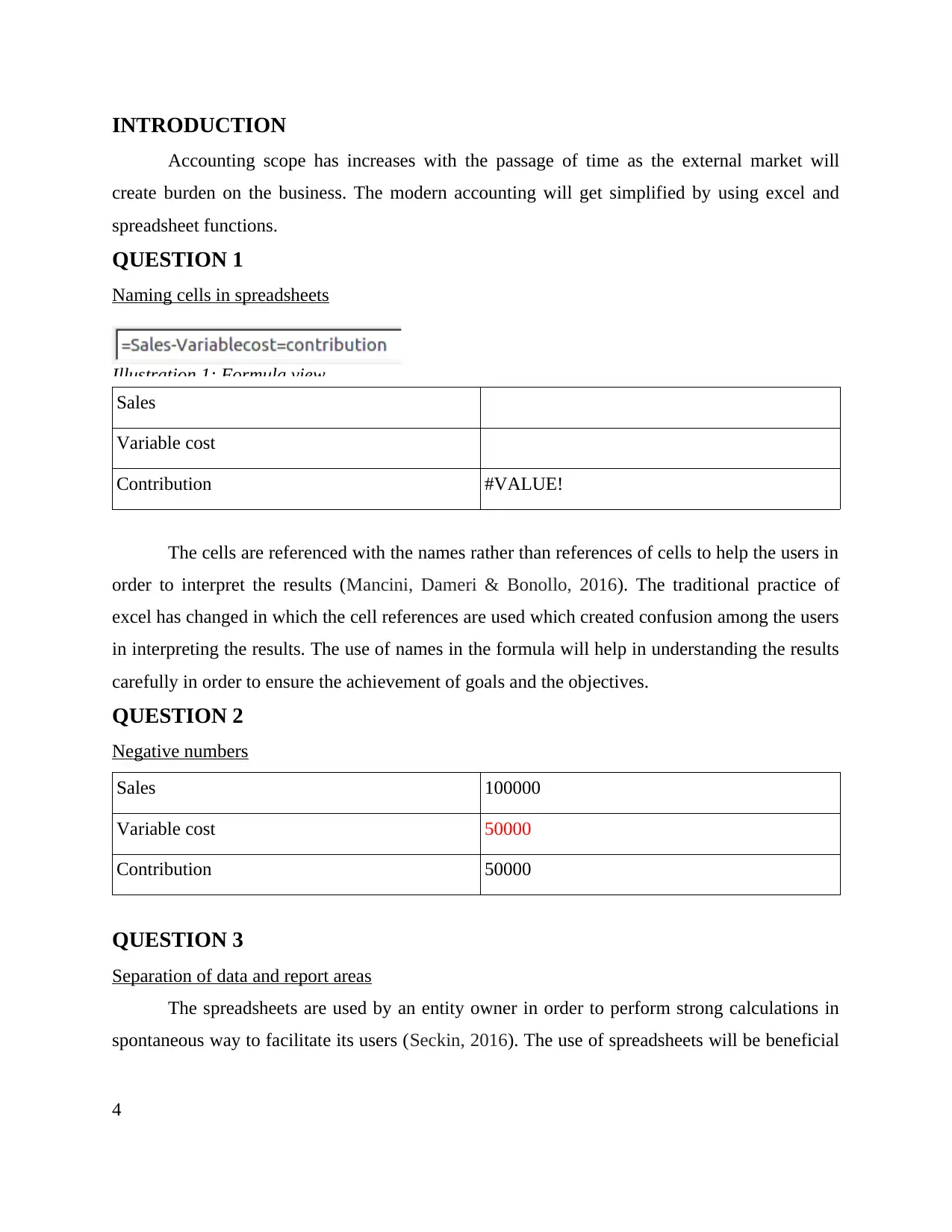
INTRODUCTION
Accounting scope has increases with the passage of time as the external market will
create burden on the business. The modern accounting will get simplified by using excel and
spreadsheet functions.
QUESTION 1
Naming cells in spreadsheets
Illustration 1: Formula view
Sales
Variable cost
Contribution #VALUE!
The cells are referenced with the names rather than references of cells to help the users in
order to interpret the results (Mancini, Dameri & Bonollo, 2016). The traditional practice of
excel has changed in which the cell references are used which created confusion among the users
in interpreting the results. The use of names in the formula will help in understanding the results
carefully in order to ensure the achievement of goals and the objectives.
QUESTION 2
Negative numbers
Sales 100000
Variable cost 50000
Contribution 50000
QUESTION 3
Separation of data and report areas
The spreadsheets are used by an entity owner in order to perform strong calculations in
spontaneous way to facilitate its users (Seckin, 2016). The use of spreadsheets will be beneficial
4
Accounting scope has increases with the passage of time as the external market will
create burden on the business. The modern accounting will get simplified by using excel and
spreadsheet functions.
QUESTION 1
Naming cells in spreadsheets
Illustration 1: Formula view
Sales
Variable cost
Contribution #VALUE!
The cells are referenced with the names rather than references of cells to help the users in
order to interpret the results (Mancini, Dameri & Bonollo, 2016). The traditional practice of
excel has changed in which the cell references are used which created confusion among the users
in interpreting the results. The use of names in the formula will help in understanding the results
carefully in order to ensure the achievement of goals and the objectives.
QUESTION 2
Negative numbers
Sales 100000
Variable cost 50000
Contribution 50000
QUESTION 3
Separation of data and report areas
The spreadsheets are used by an entity owner in order to perform strong calculations in
spontaneous way to facilitate its users (Seckin, 2016). The use of spreadsheets will be beneficial
4
Paraphrase This Document
Need a fresh take? Get an instant paraphrase of this document with our AI Paraphraser
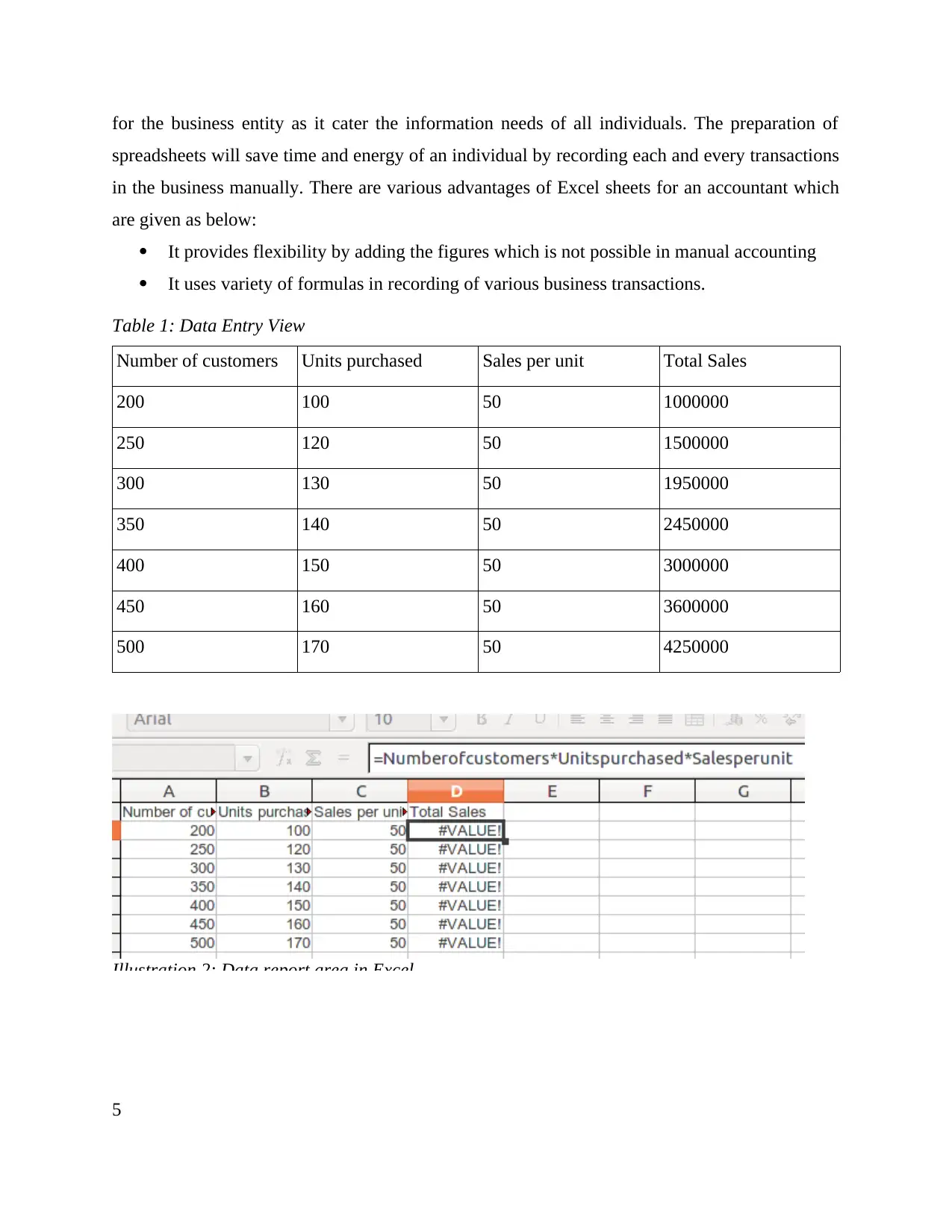
for the business entity as it cater the information needs of all individuals. The preparation of
spreadsheets will save time and energy of an individual by recording each and every transactions
in the business manually. There are various advantages of Excel sheets for an accountant which
are given as below:
It provides flexibility by adding the figures which is not possible in manual accounting
It uses variety of formulas in recording of various business transactions.
Table 1: Data Entry View
Number of customers Units purchased Sales per unit Total Sales
200 100 50 1000000
250 120 50 1500000
300 130 50 1950000
350 140 50 2450000
400 150 50 3000000
450 160 50 3600000
500 170 50 4250000
Illustration 2: Data report area in Excel
5
spreadsheets will save time and energy of an individual by recording each and every transactions
in the business manually. There are various advantages of Excel sheets for an accountant which
are given as below:
It provides flexibility by adding the figures which is not possible in manual accounting
It uses variety of formulas in recording of various business transactions.
Table 1: Data Entry View
Number of customers Units purchased Sales per unit Total Sales
200 100 50 1000000
250 120 50 1500000
300 130 50 1950000
350 140 50 2450000
400 150 50 3000000
450 160 50 3600000
500 170 50 4250000
Illustration 2: Data report area in Excel
5
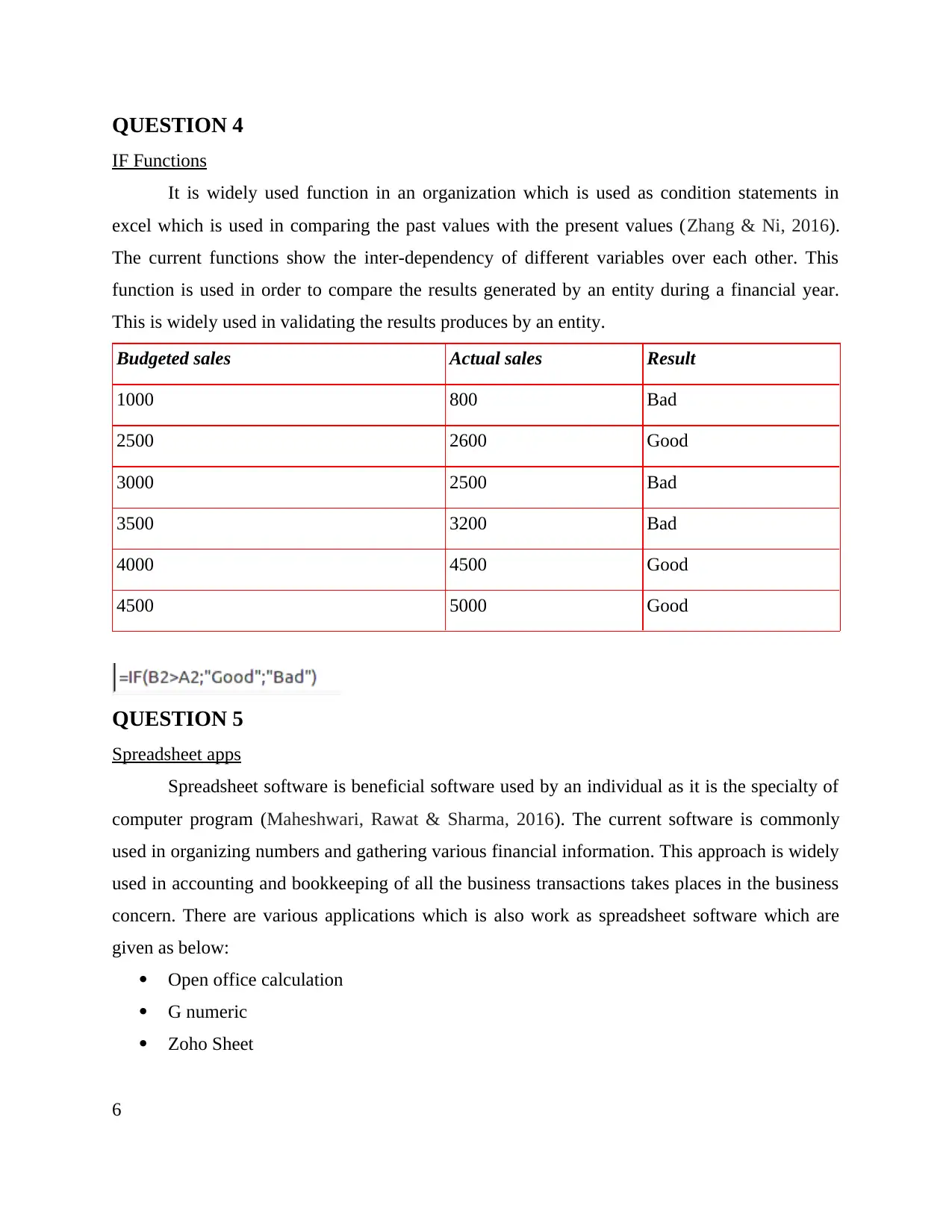
QUESTION 4
IF Functions
It is widely used function in an organization which is used as condition statements in
excel which is used in comparing the past values with the present values (Zhang & Ni, 2016).
The current functions show the inter-dependency of different variables over each other. This
function is used in order to compare the results generated by an entity during a financial year.
This is widely used in validating the results produces by an entity.
Budgeted sales Actual sales Result
1000 800 Bad
2500 2600 Good
3000 2500 Bad
3500 3200 Bad
4000 4500 Good
4500 5000 Good
QUESTION 5
Spreadsheet apps
Spreadsheet software is beneficial software used by an individual as it is the specialty of
computer program (Maheshwari, Rawat & Sharma, 2016). The current software is commonly
used in organizing numbers and gathering various financial information. This approach is widely
used in accounting and bookkeeping of all the business transactions takes places in the business
concern. There are various applications which is also work as spreadsheet software which are
given as below:
Open office calculation
G numeric
Zoho Sheet
6
IF Functions
It is widely used function in an organization which is used as condition statements in
excel which is used in comparing the past values with the present values (Zhang & Ni, 2016).
The current functions show the inter-dependency of different variables over each other. This
function is used in order to compare the results generated by an entity during a financial year.
This is widely used in validating the results produces by an entity.
Budgeted sales Actual sales Result
1000 800 Bad
2500 2600 Good
3000 2500 Bad
3500 3200 Bad
4000 4500 Good
4500 5000 Good
QUESTION 5
Spreadsheet apps
Spreadsheet software is beneficial software used by an individual as it is the specialty of
computer program (Maheshwari, Rawat & Sharma, 2016). The current software is commonly
used in organizing numbers and gathering various financial information. This approach is widely
used in accounting and bookkeeping of all the business transactions takes places in the business
concern. There are various applications which is also work as spreadsheet software which are
given as below:
Open office calculation
G numeric
Zoho Sheet
6
⊘ This is a preview!⊘
Do you want full access?
Subscribe today to unlock all pages.

Trusted by 1+ million students worldwide
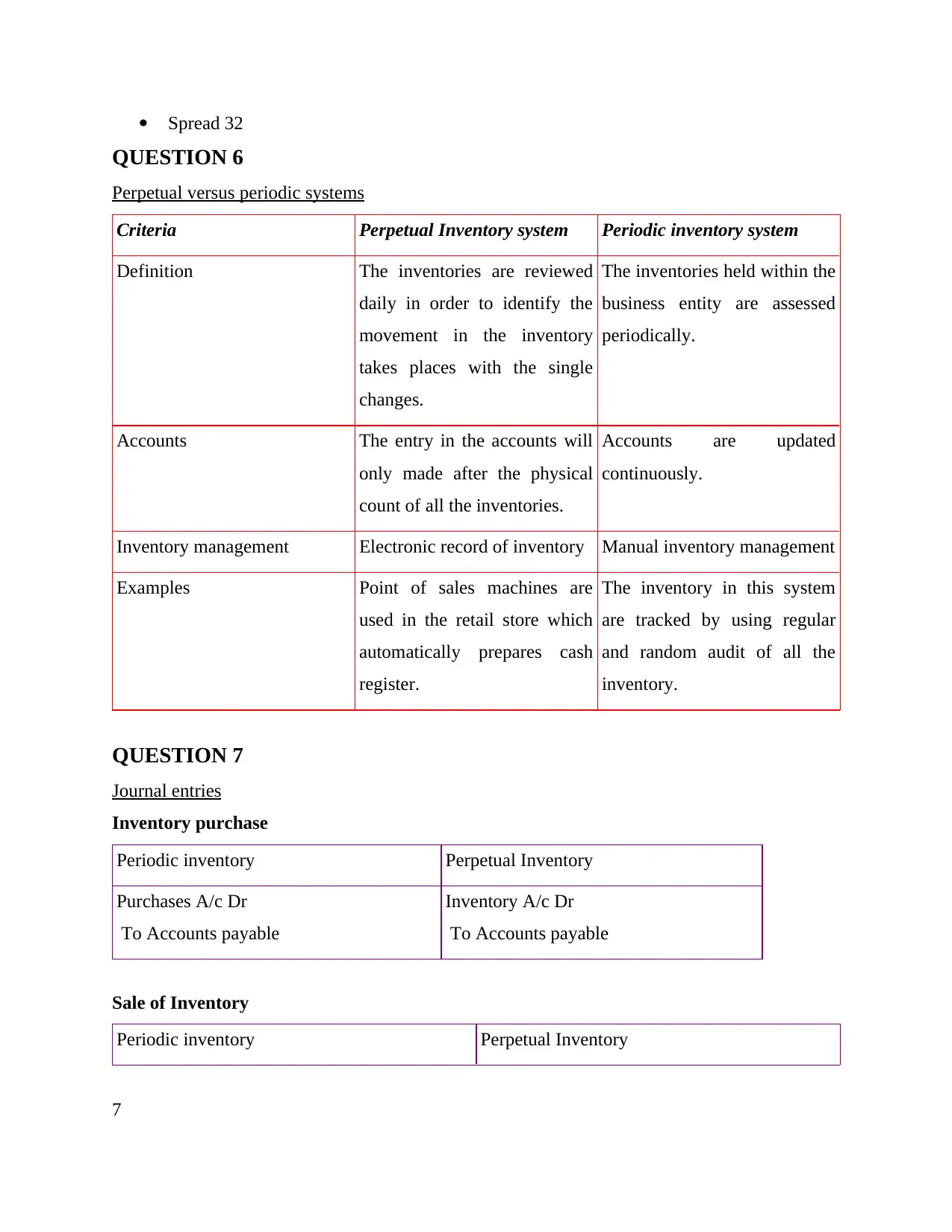
Spread 32
QUESTION 6
Perpetual versus periodic systems
Criteria Perpetual Inventory system Periodic inventory system
Definition The inventories are reviewed
daily in order to identify the
movement in the inventory
takes places with the single
changes.
The inventories held within the
business entity are assessed
periodically.
Accounts The entry in the accounts will
only made after the physical
count of all the inventories.
Accounts are updated
continuously.
Inventory management Electronic record of inventory Manual inventory management
Examples Point of sales machines are
used in the retail store which
automatically prepares cash
register.
The inventory in this system
are tracked by using regular
and random audit of all the
inventory.
QUESTION 7
Journal entries
Inventory purchase
Periodic inventory Perpetual Inventory
Purchases A/c Dr
To Accounts payable
Inventory A/c Dr
To Accounts payable
Sale of Inventory
Periodic inventory Perpetual Inventory
7
QUESTION 6
Perpetual versus periodic systems
Criteria Perpetual Inventory system Periodic inventory system
Definition The inventories are reviewed
daily in order to identify the
movement in the inventory
takes places with the single
changes.
The inventories held within the
business entity are assessed
periodically.
Accounts The entry in the accounts will
only made after the physical
count of all the inventories.
Accounts are updated
continuously.
Inventory management Electronic record of inventory Manual inventory management
Examples Point of sales machines are
used in the retail store which
automatically prepares cash
register.
The inventory in this system
are tracked by using regular
and random audit of all the
inventory.
QUESTION 7
Journal entries
Inventory purchase
Periodic inventory Perpetual Inventory
Purchases A/c Dr
To Accounts payable
Inventory A/c Dr
To Accounts payable
Sale of Inventory
Periodic inventory Perpetual Inventory
7
Paraphrase This Document
Need a fresh take? Get an instant paraphrase of this document with our AI Paraphraser
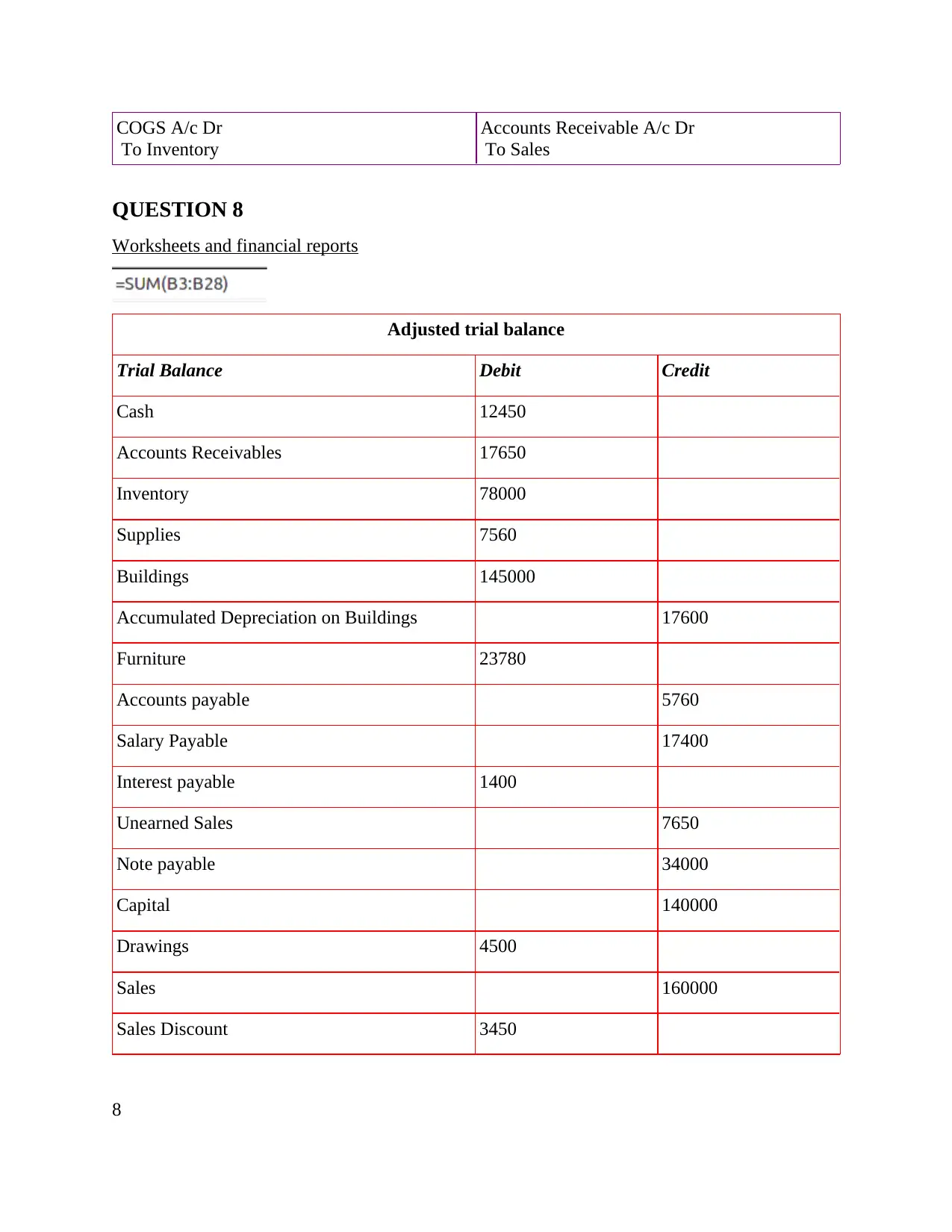
COGS A/c Dr
To Inventory
Accounts Receivable A/c Dr
To Sales
QUESTION 8
Worksheets and financial reports
Adjusted trial balance
Trial Balance Debit Credit
Cash 12450
Accounts Receivables 17650
Inventory 78000
Supplies 7560
Buildings 145000
Accumulated Depreciation on Buildings 17600
Furniture 23780
Accounts payable 5760
Salary Payable 17400
Interest payable 1400
Unearned Sales 7650
Note payable 34000
Capital 140000
Drawings 4500
Sales 160000
Sales Discount 3450
8
To Inventory
Accounts Receivable A/c Dr
To Sales
QUESTION 8
Worksheets and financial reports
Adjusted trial balance
Trial Balance Debit Credit
Cash 12450
Accounts Receivables 17650
Inventory 78000
Supplies 7560
Buildings 145000
Accumulated Depreciation on Buildings 17600
Furniture 23780
Accounts payable 5760
Salary Payable 17400
Interest payable 1400
Unearned Sales 7650
Note payable 34000
Capital 140000
Drawings 4500
Sales 160000
Sales Discount 3450
8
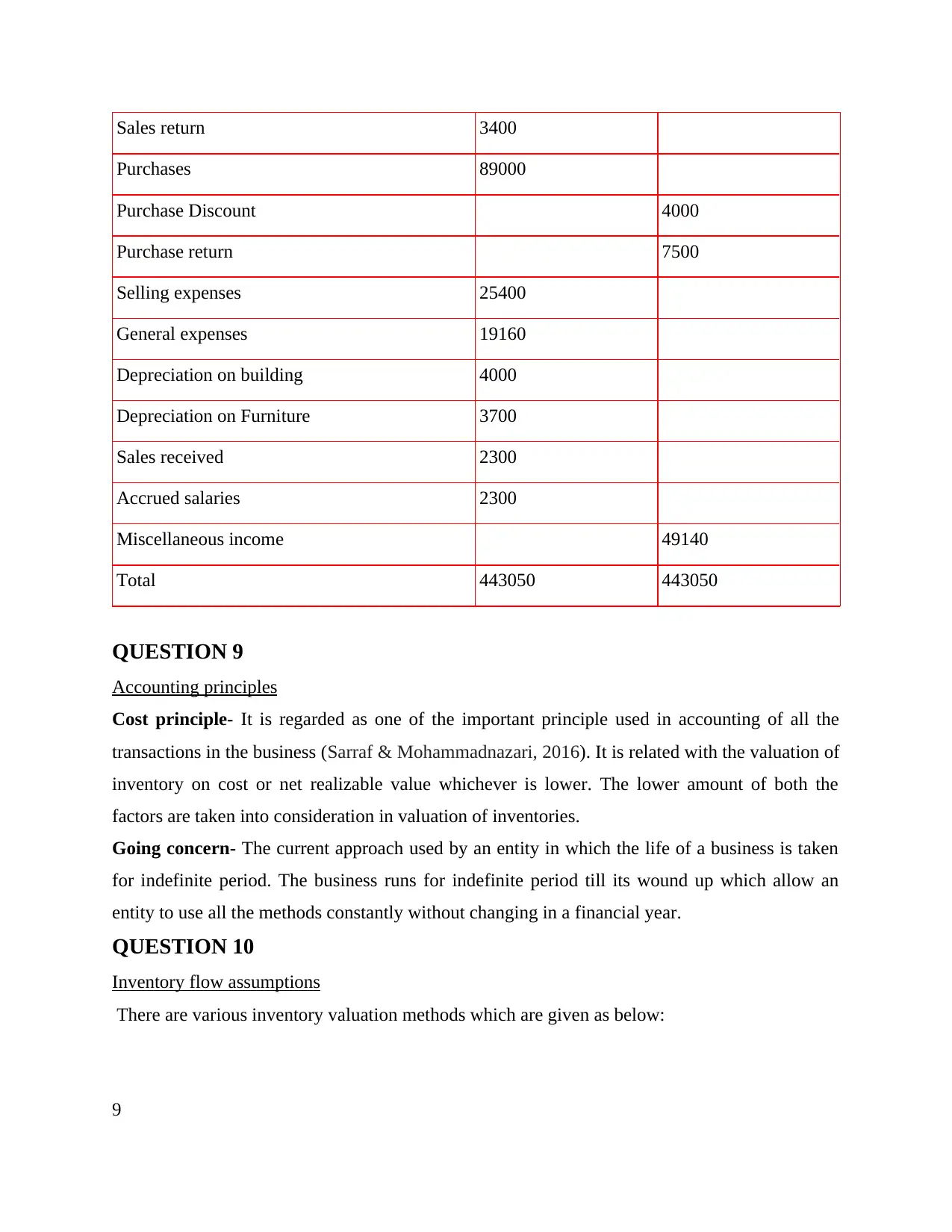
Sales return 3400
Purchases 89000
Purchase Discount 4000
Purchase return 7500
Selling expenses 25400
General expenses 19160
Depreciation on building 4000
Depreciation on Furniture 3700
Sales received 2300
Accrued salaries 2300
Miscellaneous income 49140
Total 443050 443050
QUESTION 9
Accounting principles
Cost principle- It is regarded as one of the important principle used in accounting of all the
transactions in the business (Sarraf & Mohammadnazari, 2016). It is related with the valuation of
inventory on cost or net realizable value whichever is lower. The lower amount of both the
factors are taken into consideration in valuation of inventories.
Going concern- The current approach used by an entity in which the life of a business is taken
for indefinite period. The business runs for indefinite period till its wound up which allow an
entity to use all the methods constantly without changing in a financial year.
QUESTION 10
Inventory flow assumptions
There are various inventory valuation methods which are given as below:
9
Purchases 89000
Purchase Discount 4000
Purchase return 7500
Selling expenses 25400
General expenses 19160
Depreciation on building 4000
Depreciation on Furniture 3700
Sales received 2300
Accrued salaries 2300
Miscellaneous income 49140
Total 443050 443050
QUESTION 9
Accounting principles
Cost principle- It is regarded as one of the important principle used in accounting of all the
transactions in the business (Sarraf & Mohammadnazari, 2016). It is related with the valuation of
inventory on cost or net realizable value whichever is lower. The lower amount of both the
factors are taken into consideration in valuation of inventories.
Going concern- The current approach used by an entity in which the life of a business is taken
for indefinite period. The business runs for indefinite period till its wound up which allow an
entity to use all the methods constantly without changing in a financial year.
QUESTION 10
Inventory flow assumptions
There are various inventory valuation methods which are given as below:
9
⊘ This is a preview!⊘
Do you want full access?
Subscribe today to unlock all pages.

Trusted by 1+ million students worldwide
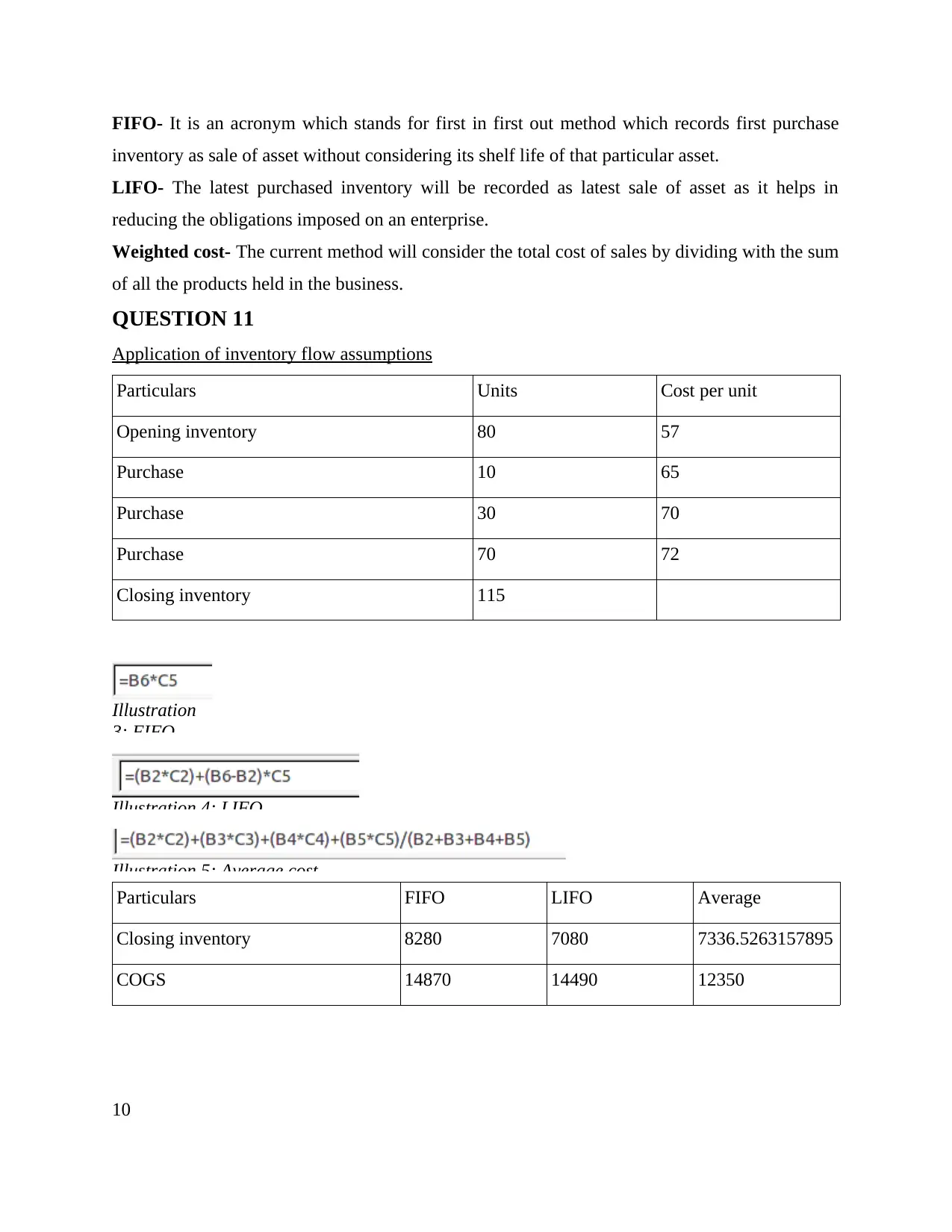
FIFO- It is an acronym which stands for first in first out method which records first purchase
inventory as sale of asset without considering its shelf life of that particular asset.
LIFO- The latest purchased inventory will be recorded as latest sale of asset as it helps in
reducing the obligations imposed on an enterprise.
Weighted cost- The current method will consider the total cost of sales by dividing with the sum
of all the products held in the business.
QUESTION 11
Application of inventory flow assumptions
Particulars Units Cost per unit
Opening inventory 80 57
Purchase 10 65
Purchase 30 70
Purchase 70 72
Closing inventory 115
Illustration
3: FIFO
Illustration 4: LIFO
Illustration 5: Average cost
Particulars FIFO LIFO Average
Closing inventory 8280 7080 7336.5263157895
COGS 14870 14490 12350
10
inventory as sale of asset without considering its shelf life of that particular asset.
LIFO- The latest purchased inventory will be recorded as latest sale of asset as it helps in
reducing the obligations imposed on an enterprise.
Weighted cost- The current method will consider the total cost of sales by dividing with the sum
of all the products held in the business.
QUESTION 11
Application of inventory flow assumptions
Particulars Units Cost per unit
Opening inventory 80 57
Purchase 10 65
Purchase 30 70
Purchase 70 72
Closing inventory 115
Illustration
3: FIFO
Illustration 4: LIFO
Illustration 5: Average cost
Particulars FIFO LIFO Average
Closing inventory 8280 7080 7336.5263157895
COGS 14870 14490 12350
10
Paraphrase This Document
Need a fresh take? Get an instant paraphrase of this document with our AI Paraphraser
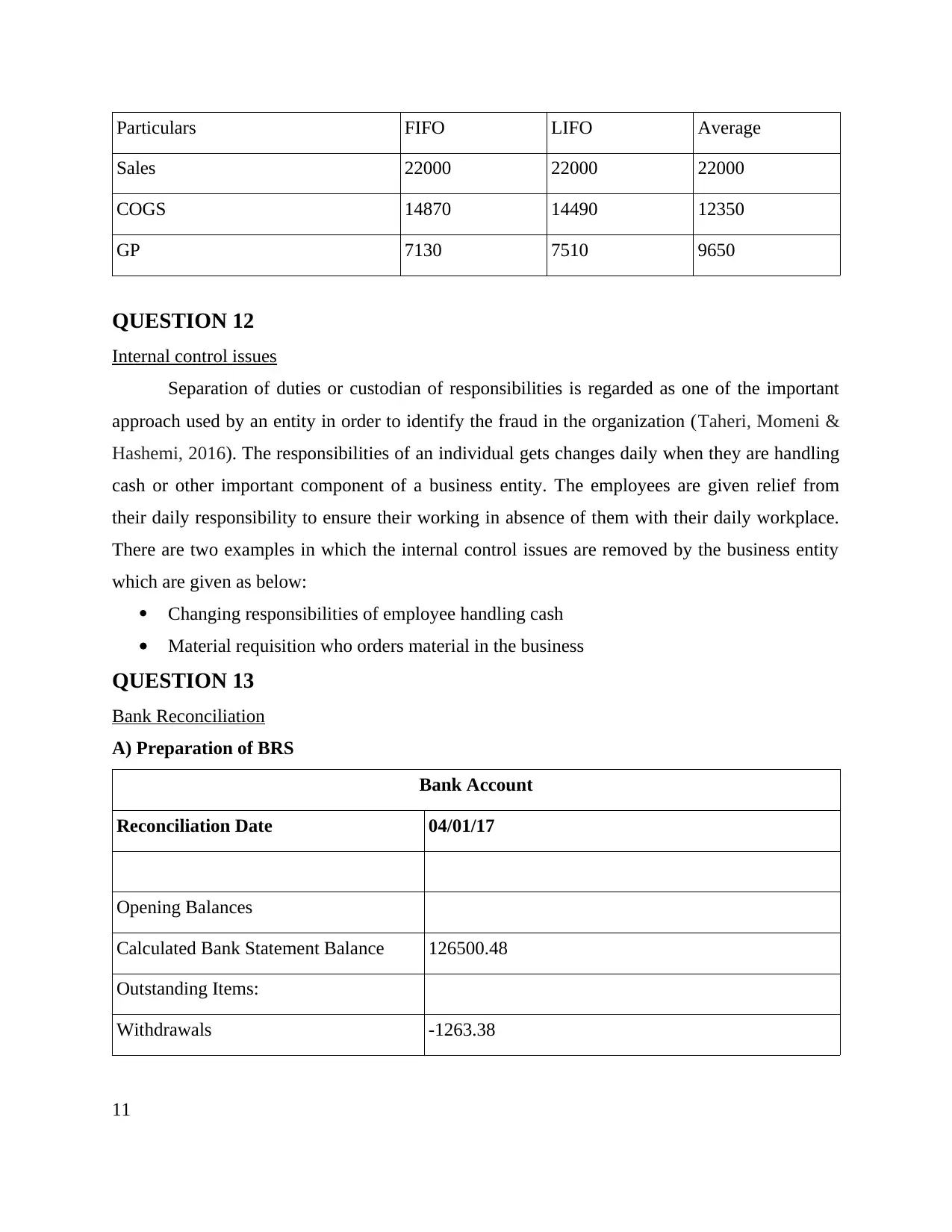
Particulars FIFO LIFO Average
Sales 22000 22000 22000
COGS 14870 14490 12350
GP 7130 7510 9650
QUESTION 12
Internal control issues
Separation of duties or custodian of responsibilities is regarded as one of the important
approach used by an entity in order to identify the fraud in the organization (Taheri, Momeni &
Hashemi, 2016). The responsibilities of an individual gets changes daily when they are handling
cash or other important component of a business entity. The employees are given relief from
their daily responsibility to ensure their working in absence of them with their daily workplace.
There are two examples in which the internal control issues are removed by the business entity
which are given as below:
Changing responsibilities of employee handling cash
Material requisition who orders material in the business
QUESTION 13
Bank Reconciliation
A) Preparation of BRS
Bank Account
Reconciliation Date 04/01/17
Opening Balances
Calculated Bank Statement Balance 126500.48
Outstanding Items:
Withdrawals -1263.38
11
Sales 22000 22000 22000
COGS 14870 14490 12350
GP 7130 7510 9650
QUESTION 12
Internal control issues
Separation of duties or custodian of responsibilities is regarded as one of the important
approach used by an entity in order to identify the fraud in the organization (Taheri, Momeni &
Hashemi, 2016). The responsibilities of an individual gets changes daily when they are handling
cash or other important component of a business entity. The employees are given relief from
their daily responsibility to ensure their working in absence of them with their daily workplace.
There are two examples in which the internal control issues are removed by the business entity
which are given as below:
Changing responsibilities of employee handling cash
Material requisition who orders material in the business
QUESTION 13
Bank Reconciliation
A) Preparation of BRS
Bank Account
Reconciliation Date 04/01/17
Opening Balances
Calculated Bank Statement Balance 126500.48
Outstanding Items:
Withdrawals -1263.38
11
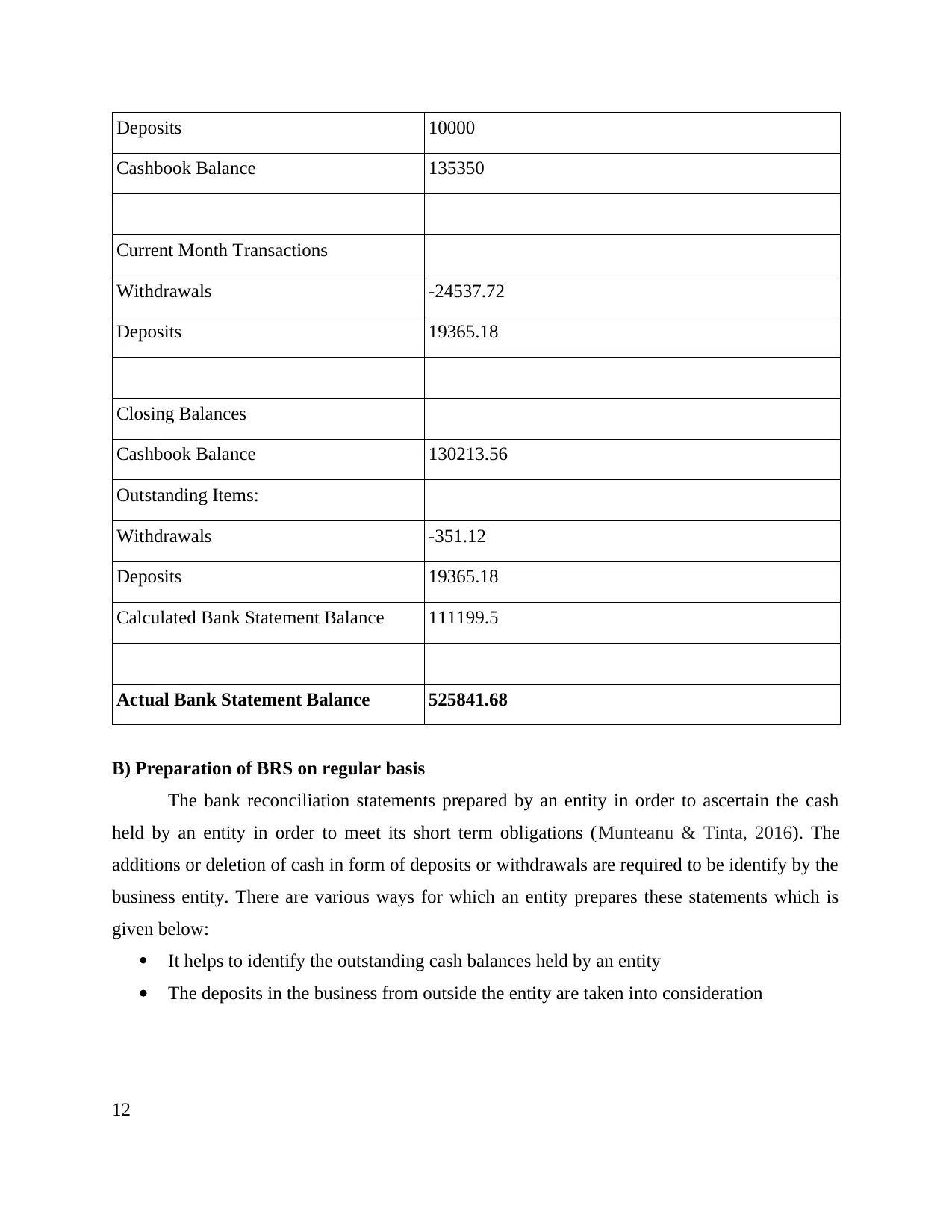
Deposits 10000
Cashbook Balance 135350
Current Month Transactions
Withdrawals -24537.72
Deposits 19365.18
Closing Balances
Cashbook Balance 130213.56
Outstanding Items:
Withdrawals -351.12
Deposits 19365.18
Calculated Bank Statement Balance 111199.5
Actual Bank Statement Balance 525841.68
B) Preparation of BRS on regular basis
The bank reconciliation statements prepared by an entity in order to ascertain the cash
held by an entity in order to meet its short term obligations (Munteanu & Tinta, 2016). The
additions or deletion of cash in form of deposits or withdrawals are required to be identify by the
business entity. There are various ways for which an entity prepares these statements which is
given below:
It helps to identify the outstanding cash balances held by an entity
The deposits in the business from outside the entity are taken into consideration
12
Cashbook Balance 135350
Current Month Transactions
Withdrawals -24537.72
Deposits 19365.18
Closing Balances
Cashbook Balance 130213.56
Outstanding Items:
Withdrawals -351.12
Deposits 19365.18
Calculated Bank Statement Balance 111199.5
Actual Bank Statement Balance 525841.68
B) Preparation of BRS on regular basis
The bank reconciliation statements prepared by an entity in order to ascertain the cash
held by an entity in order to meet its short term obligations (Munteanu & Tinta, 2016). The
additions or deletion of cash in form of deposits or withdrawals are required to be identify by the
business entity. There are various ways for which an entity prepares these statements which is
given below:
It helps to identify the outstanding cash balances held by an entity
The deposits in the business from outside the entity are taken into consideration
12
⊘ This is a preview!⊘
Do you want full access?
Subscribe today to unlock all pages.

Trusted by 1+ million students worldwide
1 out of 20
Related Documents
Your All-in-One AI-Powered Toolkit for Academic Success.
+13062052269
info@desklib.com
Available 24*7 on WhatsApp / Email
![[object Object]](/_next/static/media/star-bottom.7253800d.svg)
Unlock your academic potential
Copyright © 2020–2025 A2Z Services. All Rights Reserved. Developed and managed by ZUCOL.





